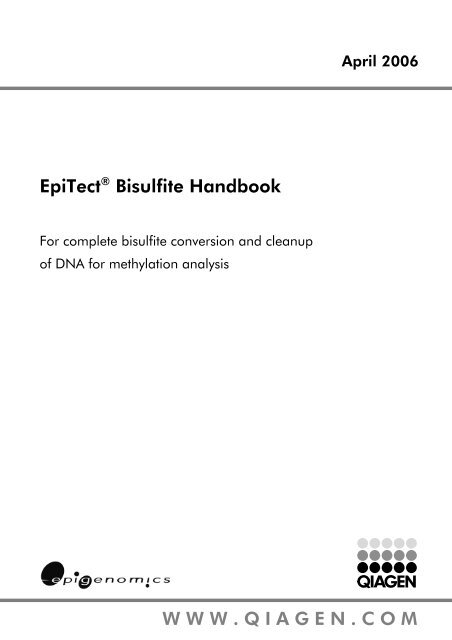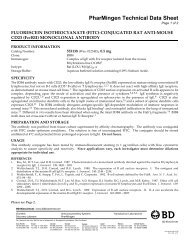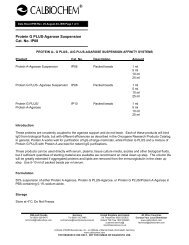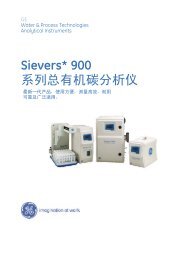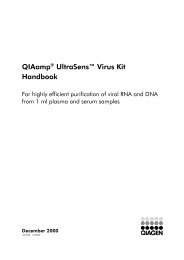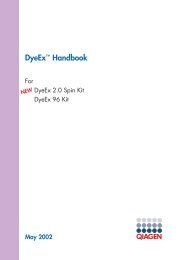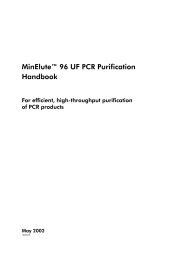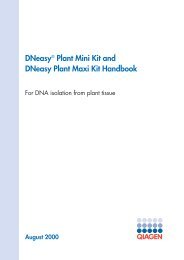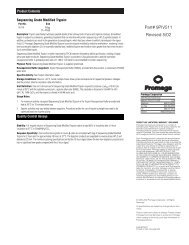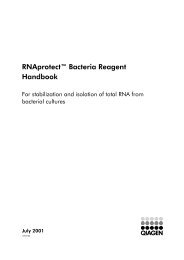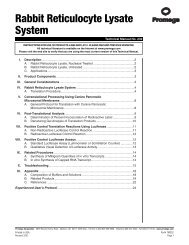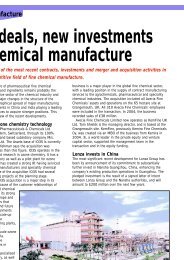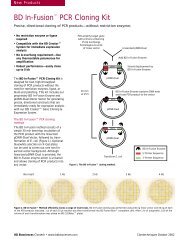EpiTect Bisulfite Handbook
EpiTect Bisulfite Handbook
EpiTect Bisulfite Handbook
Create successful ePaper yourself
Turn your PDF publications into a flip-book with our unique Google optimized e-Paper software.
<strong>EpiTect</strong> ® <strong>Bisulfite</strong> <strong>Handbook</strong><br />
For complete bisulfite conversion and cleanup<br />
of DNA for methylation analysis<br />
April 2006<br />
WWW.QIAGEN.COM
Trademarks: QIAGEN ® , QIAamp ® , BioRobot ® , DNeasy ® , <strong>EpiTect</strong> ® , FlexiGene ® , MagAttract ® (QIAGEN Group); Eppendorf ® (Eppendorf-Netheler-Hinz<br />
GmbH).<br />
The <strong>EpiTect</strong> <strong>Bisulfite</strong> Kit Chemical Module was developed in cooperation with Epigenomics.<br />
Use of methylation specific PCR (MSP) is covered by US patents 5,786,146, 6,017,704, 6,200,756 & 6,265,171 and corresponding foreign<br />
patents and applications. No license under these patents to use the MSP process is conveyed to the purchaser by purchasing this product<br />
The PCR process is covered by the foreign counterparts of U.S. Patents Nos. 4,683,202 and 4,683,195 owned by F. Hoffmann-La Roche Ltd.<br />
© 2006 QIAGEN, all rights reserved.
Contents<br />
Kit Contents 4<br />
Shipping and Storage 4<br />
Product Use Limitations 5<br />
Product Warranty and Satisfaction Guarantee 5<br />
Technical Assistance 5<br />
Safety Information 6<br />
Quality Control 7<br />
Introduction 8<br />
DNA input (amount and quality) 9<br />
Principle and procedure 9<br />
<strong>Bisulfite</strong> Mix 10<br />
DNA Protect Buffer 11<br />
<strong>Bisulfite</strong> thermal cycling 11<br />
Carrier RNA 11<br />
Optimized buffers 11<br />
Storage stability of converted and purified DNA 11<br />
Equipment and Reagents to Be Supplied by User 12<br />
Important Notes 13<br />
Protocols<br />
� Sodium <strong>Bisulfite</strong> Conversion of Unmethylated Cytosines in DNA 15<br />
� Sodium <strong>Bisulfite</strong> Conversion of Unmethylated Cytosines in DNA<br />
from Solutions with Low Concentrations of DNA 20<br />
� Sodium <strong>Bisulfite</strong> Conversion of Unmethylated Cytosines in DNA<br />
Isolated from FFPE Tissue Samples 24<br />
Troubleshooting Guide 29<br />
Ordering Information 32<br />
QIAGEN Distributors and Importers 35<br />
<strong>EpiTect</strong> <strong>Bisulfite</strong> <strong>Handbook</strong> 04/2006 3
Kit Contents<br />
<strong>EpiTect</strong> <strong>Bisulfite</strong> Kit (48)<br />
Catalog no. 59104<br />
Number of preps<br />
Chemical Module<br />
48<br />
<strong>Bisulfite</strong> Mix (aliquots for 8 reactions) 6<br />
DNA Protect Buffer 1.9 ml<br />
RNase-Free Water 3 x 1.9 ml<br />
Purification Module<br />
<strong>EpiTect</strong> Spin Columns 48<br />
Collection Tubes (2 ml) 96<br />
Buffer BL* 31 ml<br />
Buffer BW (concentrate) 2 x 13 ml<br />
Buffer BD (concentrate) 3 ml<br />
Buffer EB 15 ml<br />
Carrier RNA 310 µg<br />
<strong>Handbook</strong> 1<br />
* Contains a guanidine salt. Not compatible with disinfectants containing bleach. See “Safety<br />
Information” (page 6).<br />
Shipping and Storage<br />
The <strong>EpiTect</strong> <strong>Bisulfite</strong> Kit is shipped at room temperature (15–25°C). Upon<br />
arrival, <strong>EpiTect</strong> <strong>Bisulfite</strong> spin columns should be stored at 2–8°C. However,<br />
short-term storage (up to 4 weeks) at room temperature does not affect their<br />
performance.<br />
All buffers and the <strong>Bisulfite</strong> Mix should be stored at room temperature<br />
(15–25°C) and are stable for at least 6 months under these conditions.<br />
Reconstituted <strong>Bisulfite</strong> Mix can be stored at –20°C for up to 4 weeks.<br />
Lyophilized carrier RNA can be stored at room temperature (15–25°C) for one<br />
year. Carrier RNA can only be dissolved in RNase-free water; dissolved carrier<br />
RNA should be immediately added to Buffer BL as described on page 11. This<br />
solution should be prepared fresh, and is stable at 2–8°C for up to 48 hours.<br />
4 <strong>EpiTect</strong> <strong>Bisulfite</strong> <strong>Handbook</strong> 04/2006
Unused portions of carrier RNA dissolved in RNase-free water should be frozen<br />
in aliquots at –20°C.<br />
Product Use Limitations<br />
The <strong>EpiTect</strong> <strong>Bisulfite</strong> Kit is developed, designed, and sold for research purposes<br />
only. It is not to be used for human diagnostic or drug purposes or to be<br />
administered to humans. All due care and attention should be exercised in the<br />
handling of many of the materials described in this text.<br />
Product Warranty and Satisfaction Guarantee<br />
QIAGEN guarantees the performance of all products in the manner described<br />
in our product literature. The purchaser must determine the suitability of the<br />
product for its particular use. Should any product fail to perform satisfactorily<br />
due to any reason other than misuse, QIAGEN will replace it free of charge or<br />
refund the purchase price. We reserve the right to change, alter, or modify any<br />
product to enhance its performance and design. If a QIAGEN ® product does<br />
not meet your expectations, simply call your local Technical Service Department<br />
or distributor. We will credit your account or exchange the product — as you<br />
wish. Separate conditions apply to QIAGEN scientific instruments, service<br />
products, and to products shipped on dry ice. Please inquire for more<br />
information.<br />
A copy of QIAGEN terms and conditions can be obtained on request, and is<br />
also provided on the back of our invoices. If you have questions about product<br />
specifications or performance, please call QIAGEN Technical Services or your<br />
local distributor (see back cover).<br />
Technical Assistance<br />
At QIAGEN we pride ourselves on the quality and availability of our technical<br />
support. Our Technical Service Departments are staffed by experienced<br />
scientists with extensive practical and theoretical expertise in molecular biology<br />
and the use of QIAGEN products. If you have any questions or experience any<br />
difficulties regarding the <strong>EpiTect</strong> <strong>Bisulfite</strong> Kit or QIAGEN products in general,<br />
please do not hesitate to contact us.<br />
QIAGEN customers are a major source of information regarding advanced or<br />
specialized uses of our products. This information is helpful to other scientists as<br />
well as to the researchers at QIAGEN. We therefore encourage you to contact<br />
us if you have any suggestions about product performance or new applications<br />
and techniques.<br />
For technical assistance and more information please call one of the QIAGEN<br />
Technical Service Departments or local distributors (see back cover).<br />
<strong>EpiTect</strong> <strong>Bisulfite</strong> <strong>Handbook</strong> 04/2006 5
Safety Information<br />
When working with chemicals, always wear a suitable lab coat, disposable<br />
gloves, and protective goggles. For more information, please consult the<br />
appropriate material safety data sheets (MSDSs). These are available online in<br />
convenient and compact PDF format at www.qiagen.com/ts/msds.asp where<br />
you can find, view, and print the MSDS for each QIAGEN kit and kit<br />
component.<br />
CAUTION: DO NOT add bleach or acidic solutions directly to waste<br />
containing Buffer BL.<br />
Buffer BL contains a guanidine salt, which can form highly reactive compounds<br />
when combined with bleach. If liquid containing this buffer is spilt, clean with<br />
suitable laboratory detergent and water.<br />
The following risk and safety phrases apply to components of <strong>EpiTect</strong> <strong>Bisulfite</strong><br />
Kit.<br />
<strong>Bisulfite</strong> Mix<br />
Contains sodium bisulfite: sensitizer, irritant. Risk and safety phrases:* R22-31-<br />
41, S13-26-36/37/39-46<br />
Buffer BD<br />
Contains sodium hydroxide: corrosive. Risk and safety phrases:* R35, S26-<br />
36/37/39-45<br />
Buffer BL<br />
Contains guanidine thiocyanate: harmful. Risk and safety phrases:* R20/21/22-<br />
32, S13-26-36-46<br />
DNA Protect Buffer<br />
Contains Tetrahydrofurfuryl alcohol: irritant. Risk and safety phrases:* R36, S13-<br />
26-36/37/39-46<br />
* R20/21/22: Harmful by inhalation, in contact with skin and if swallowed; R22: Harmful if<br />
swallowed; R31: Contact with acids liberates toxic gas; R32: Contact with acids liberates very<br />
toxic gas ; R35: Causes severe burns; R36: Irritating to eyes; R41: Risk of serious damage to<br />
eyes; S13: Keep away from food, drink and animal feedingstuffs ;S26: In case of contact<br />
with eyes, rinse immediately with plenty of water and seek medical advice ;36/37/39: Wear<br />
suitable protective clothing, gloves and eye/face protection; S36: Wear suitable protective<br />
clothing; S45: In case of accident or if you feel unwell, seek medical advice immediately<br />
(show the label where possible); S46: If swallowed, seek medical advice immediately and<br />
show container or label.<br />
6 <strong>EpiTect</strong> <strong>Bisulfite</strong> <strong>Handbook</strong> 04/2006
24-hour emergency information<br />
Emergency medical information in English, French, and German can be<br />
obtained 24 hours a day from:<br />
Poison Information Center Mainz, Germany<br />
Tel: +49-6131-19240<br />
Quality Control<br />
In accordance with QIAGEN’s ISO-certified Quality Management System, each<br />
lot of <strong>EpiTect</strong> <strong>Bisulfite</strong> Kits is tested against predetermined specifications to<br />
ensure consistent product quality.<br />
<strong>EpiTect</strong> <strong>Bisulfite</strong> <strong>Handbook</strong> 04/2006 7
Introduction<br />
Epigenetics describes the study of heritable changes in gene function that occur<br />
without a change in the nuclear DNA sequence. In addition to RNA-associated<br />
silencing and histone modification, a major epigenetic mechanism in higherorder<br />
eukaryotes is DNA methylation.<br />
Methylation of DNA occurs on cytosine residues, especially on CpG<br />
dinucleotides enriched in small regions of DNA (55%, are known as CpG islands. They are usually clustered<br />
around the regulatory region of genes and can affect the transcriptional<br />
regulation of these genes. Methylation of CpG islands by DNA methylases has<br />
been shown to be associated with gene inactivation and plays an important role<br />
in the development of cancer and cell aging. Reversal of DNA methylation at<br />
these sites is a potential therapeutic strategy as this reversal may restore<br />
expression of transcriptionally silenced genes. In addition to CpG, methylated<br />
cytosine residues are also found at CpNpG or CpNpN sites (N = A, T, or C) in<br />
plants.<br />
The methylation status of a DNA sequence can best be determined using<br />
sodium bisulfite. Incubation of the target DNA with sodium bisulfite results in<br />
conversion of unmethylated cytosine residues into uracil, leaving the methylated<br />
cytosines unchanged. Therefore, bisulfite treatment gives rise to different DNA<br />
sequences for methylated and unmethylated DNA (see below).<br />
Original sequence After bisulfite treatment<br />
Unmethylated DNA N-C-G-N-C-G-N-C-G-N N-U-G-N-U-G-N-U-G-N<br />
Methylated DNA N-C-G-N-C-G-N-C-G-N N-C-G-N-C-G-N-C-G-N<br />
The most critical step for correct determination of a methylation pattern is the<br />
complete conversion of unmethylated cytosines. This is achieved by incubating<br />
the DNA in high bisulfite salt concentrations at high temperature and low pH.<br />
These harsh conditions usually lead to a high degree of DNA fragmentation<br />
and subsequent loss of DNA during purification. Purification is necessary to<br />
remove bisulfite salts and chemicals used in the conversion process that inhibit<br />
sequencing procedures. Common bisulfite procedures usually require high<br />
amounts of input DNA. However, due to DNA degradation during conversion<br />
and DNA loss during purification, such procedures often lead to low DNA yield,<br />
highly fragmented DNA, and irreproducible conversion rates.<br />
The <strong>EpiTect</strong> <strong>Bisulfite</strong> Kit now provides a fast and streamlined 6-hour procedure<br />
for efficient DNA conversion and purification of as little as 1 ng DNA. DNA<br />
fragmentation is prevented during the bisulfite conversion reaction by a unique<br />
8 <strong>EpiTect</strong> <strong>Bisulfite</strong> <strong>Handbook</strong> 04/2006
DNA Protect Buffer that contains a pH-indicator dye as a mixing control in<br />
reaction setup, allowing confirmation of the correct pH for cytosine conversion.<br />
Furthermore, the bisulfite thermal cycling program provides an optimized series<br />
of incubation steps necessary for thermal DNA denaturation and subsequent<br />
sulfonation and cytosine deamination, enabling high cytosine conversion rates<br />
of over 99%. Desulfonation, the final step in chemical conversion of cytosines, is<br />
achieved by a convenient on-column step included in the purification<br />
procedure.<br />
DNA input (amount and quality)<br />
The <strong>EpiTect</strong> <strong>Bisulfite</strong> Kit is suited for wide range of DNA starting amounts. The<br />
standard protocol “Sodium <strong>Bisulfite</strong> Conversion of Unmethylated Cytosines in<br />
DNA” on page 15, can be used for conversion of 2 µg – 1 ng DNA.<br />
To efficiently convert very small amounts of DNA from limited and/or precious<br />
samples, such as low concentrations of DNA in solution from microdissected<br />
biopsies or freely circulating DNA, the protocol ”Sodium <strong>Bisulfite</strong> Conversion of<br />
Unmethylated Cytosines in DNA from Solutions with Low Concentrations of<br />
DNA ” on page 20, can be used with up to 40 µl DNA in solution for<br />
conversion of 500–1 ng DNA.<br />
The protocol “Sodium <strong>Bisulfite</strong> Conversion of Unmethylated Cytosines in DNA<br />
Isolated from FFPE Tissue Samples” on page 24 is designed for conversion of<br />
DNA from formalin-fixed, paraffin-embedded (FFPE) tissues and includes an<br />
optimized step to facilitate binding with DNA from fixed tissues. This protocol<br />
can be used with 2 µg – 1 ng DNA.<br />
All protocols achieve the same conversion rates and lead to equal recoveries<br />
after purification of converted DNA, independent of DNA starting amounts.<br />
QIAamp ® and DNeasy ® Kits enable purification of high-quality genomic DNA<br />
from a variety of sample types (including blood, tissue, body fluids, and FFPE<br />
tissues) highly suited for cytosine conversion using the <strong>EpiTect</strong> <strong>Bisulfite</strong> Kit<br />
procedure. See pages 32–34 for ordering information.<br />
Principle and procedure<br />
The <strong>EpiTect</strong> <strong>Bisulfite</strong> Kit comprises a few simple steps: bisulfite-mediated<br />
conversion of unmethylated cytosines; binding of the converted single-stranded<br />
DNA to the membrane of an <strong>EpiTect</strong> spin column; washing; desulfonation of<br />
membrane-bound DNA; washing of the membrane-bound DNA to remove<br />
desulfonation agent; and elution of the pure, converted DNA from the spin<br />
column. The eluted DNA is suited for all techniques currently used for the<br />
analysis of DNA methylation; including PCR, real-time PCR, MSP-PCR, bisulfite<br />
sequencing (direct und cloning), COBRA, and pyrosequencing.<br />
<strong>EpiTect</strong> <strong>Bisulfite</strong> <strong>Handbook</strong> 04/2006 9
Note: The protocol “Sodium <strong>Bisulfite</strong> Conversion of Unmethylated Cytosines in<br />
DNA Isolated from FFPE Tissue Samples”, page 24, includes an additional<br />
binding step, optimized for DNA from fixed tissues.<br />
<strong>Bisulfite</strong> Mix<br />
The <strong>Bisulfite</strong> Mix is conveniently provided in separate aliquots (8 conversion<br />
reactions per aliquot). The sodium bisulfite in each aliquot is supplied in a<br />
unique formulation that provides the optimum pH for complete conversion of<br />
cytosine to uracil, without the need for tedious pH adjustment. The <strong>Bisulfite</strong> Mix<br />
must be dissolved in 800 µl RNase-free water before use (see “Things to do<br />
before starting”, pages 15, 20, and 24). Reconstituted <strong>Bisulfite</strong> Mix can be<br />
stored at –20°C for up to 4 weeks.<br />
10 <strong>EpiTect</strong> <strong>Bisulfite</strong> <strong>Handbook</strong> 04/2006
DNA Protect Buffer<br />
DNA Protect Buffer is uniquely formulated to prevent the DNA fragmentation<br />
usually associated with bisulfite treatment of DNA at high temperatures and low<br />
pH values. It also provides effective DNA denaturation, resulting in the singlestranded<br />
DNA necessary for complete cytosine conversion. In addition, DNA<br />
Protect Buffer contains a pH indicator dye as a mixing control and to allow<br />
confirmation of the correct pH for cytosine conversion.<br />
<strong>Bisulfite</strong> thermal cycling<br />
The thermal cycling program provides an optimized series of incubation steps<br />
necessary for thermal DNA denaturation and subsequent sulfonation and<br />
cytosine deamination, enabling highest cytosine conversion rates.<br />
Carrier RNA<br />
Carrier RNA is provided to enhance the binding of small quantities of DNA to<br />
the <strong>EpiTect</strong> spin column membrane. If using >100 ng genomic DNA template,<br />
it is not necessary to use carrier RNA. Carrier RNA should be dissolved in<br />
RNase-free water before use (see “Things to do before starting”, pages 15, 20,<br />
and 24).<br />
Optimized buffers<br />
The <strong>EpiTect</strong> <strong>Bisulfite</strong> Kit contains carefully optimized buffers enabling maximum<br />
cytosine conversion and subsequent DNA purification. Buffer BL promotes<br />
binding of the converted single-stranded DNA to the <strong>EpiTect</strong> spin column<br />
membrane. Subsequently, the membrane-bound DNA is washed using Buffer<br />
BW, which efficiently removes residual sodium bisulfite. After desulfonation<br />
using Buffer BD, the DNA is further desalted using Buffer BW before elution<br />
from the spin column membrane using Buffer EB.<br />
Storage stability of converted and purified DNA<br />
DNA converted and purified using the <strong>EpiTect</strong> <strong>Bisulfite</strong> Kit can be stored at<br />
–20°C for at least 12 weeks without decrease in quality or conversion. Further<br />
investigations on long-term storage are ongoing. Contact QIAGEN for more<br />
information.<br />
<strong>EpiTect</strong> <strong>Bisulfite</strong> <strong>Handbook</strong> 04/2006 11
Equipment and Reagents to Be Supplied by User<br />
When working with chemicals, always wear a suitable lab coat, disposable<br />
gloves, and protective goggles. For more information, consult the appropriate<br />
material safety data sheets (MSDSs), available from the product supplier.<br />
� Ethanol (molecular biology grade, 96–100%)*<br />
� Pipets and pipet tips (pipet tips with aerosol barriers for preventing crosscontamination<br />
are recommended)<br />
� PCR tubes<br />
� Thermal cycler with heated lid (since the bisulfite reaction is not overlaid<br />
with mineral oil, only thermal cyclers with heated lids are suitable for this<br />
procedure)<br />
� 1.5 ml microcentrifuge tubes for elution steps (available from Brinkmann<br />
[Safe-Lock, cat. no. 022363204], Eppendorf [Safe-Lock, cat. no. 0030<br />
120.086], or Sarstedt [Safety Cap, cat. no. 72.690]). †<br />
� Microcentrifuge<br />
� Optional: Heating block, thermomixer, or heated orbital incubator (see<br />
step 1 of each protocol).<br />
* Do not use denatured alcohol, which contains other substances such as methanol or<br />
methylethylketone.<br />
†<br />
This is not a complete list of suppliers and does not include many important vendors of<br />
biological supplies.<br />
12 <strong>EpiTect</strong> <strong>Bisulfite</strong> <strong>Handbook</strong> 04/2006
Important Notes<br />
Yield and size of DNA<br />
The yield of DNA purified after bisulfite conversion depends on the amount of<br />
DNA and source of the starting material.<br />
Using the standard protocol, the <strong>EpiTect</strong> <strong>Bisulfite</strong> Kit is suited for DNA input<br />
amounts ranging from 1 ng to 2 µg, with high levels of DNA recovery<br />
throughout this range.<br />
The size of the template DNA can vary between 500 bp (in laser<br />
microdissections) and 30 kb (fresh samples or blood). DNA purified from<br />
serum, urine, or FFPE tissue may be
Processing <strong>EpiTect</strong> spin columns in a microcentrifuge<br />
� Always close <strong>EpiTect</strong> spin columns before placing them in the<br />
microcentrifuge.<br />
� For efficient parallel processing of multiple samples, we recommend filling<br />
a rack with the collection tubes into which <strong>EpiTect</strong> spin columns can be<br />
transferred after centrifugation. Collection tubes can be used several times.<br />
14 <strong>EpiTect</strong> <strong>Bisulfite</strong> <strong>Handbook</strong> 04/2006
Protocol: Sodium <strong>Bisulfite</strong> Conversion of<br />
Unmethylated Cytosines in DNA<br />
Using this protocol, 2 µg – 1 ng DNA in a volume of up to 20 µl can be<br />
processed.<br />
Important points before starting<br />
� Each aliquot of <strong>Bisulfite</strong> Mix is sufficient for 8 conversion reactions. If<br />
converting fewer than 8 DNA samples, reconstituted <strong>Bisulfite</strong> Mix can be<br />
stored at –20°C for up to 4 weeks without any loss of performance.<br />
� The DNA Protect Buffer should turn from green to blue after addition to<br />
DNA/<strong>Bisulfite</strong> Mix (step 2), indicating sufficient mixing and correct pH for<br />
the bisulfite conversion reaction.<br />
� Perform all centrifugation steps at room temperature (15–25°C).<br />
Things to do before starting<br />
� Add 30 ml ethanol (96–100%) to Buffer BW and store at room temperature<br />
(15–25°C). Invert the bottle several times before starting the procedure.<br />
� Add 27 ml ethanol (96–100%) to Buffer BD and store at room temperature.<br />
Invert the bottle several times before starting the procedure and close the<br />
bottle immediately after use. White precipitates may form after addition of<br />
ethanol. These precipitates will not affect the performance of Buffer BD.<br />
However, avoid transferring precipitates to the <strong>EpiTect</strong> spin column.<br />
� Add 310 µl RNase-free water to the lyophilized carrier RNA (310 µg) to<br />
obtain a 1 µg/µl solution. Dissolve the carrier RNA thoroughly by vortexing.<br />
When processing 48 samples at once, add the complete volume of<br />
dissolved carrier RNA to the bottle of Buffer BL, and check the box on the<br />
bottle lid label. If processing fewer samples, split the dissolved carrier RNA<br />
into conveniently sized aliquots (e.g., 50 µl) and store at –20°C. Aliquots<br />
can be stored for up to 1 year. If
� Add dissolved carrier RNA to Buffer BL. Calculate the volume of Buffer BL<br />
and dissolved carrier RNA required for the number of samples to be<br />
processed (see Table 1 for example volumes). If Buffer BL contains<br />
precipitates, dissolve by heating (maximum 70°C) with gentle agitation.<br />
� Equilibrate samples to room temperature (15–25ºC).<br />
� Optional: Set a thermomixer, heating block, or heated orbital incubator to<br />
60°C for use in step 1.<br />
Table 1. Carrier RNA and Buffer BL Volumes<br />
Number of<br />
samples<br />
Volume of<br />
Buffer BL*<br />
Volume of<br />
carrier RNA<br />
solution †<br />
1 4 8 16 24 48<br />
620 µl 2.5 ml 5 ml 10 ml 15 ml 31 ml<br />
6.2 µl 25 µl 50 µl 100 µl 150 µl 310 µl<br />
* The volumes given contain a 10% surplus for pipetting inaccuracies.<br />
† Resulting in a final concentration of 10 µg/ml carrier RNA in Buffer BL.<br />
Procedure<br />
<strong>Bisulfite</strong> DNA conversion<br />
1. Thaw DNA to be used in the bisulfite reaction. Dissolve the required<br />
number of aliquots of <strong>Bisulfite</strong> Mix by adding 800 µl RNase-free<br />
water to each aliquot. Vortex until the <strong>Bisulfite</strong> Mix is completely<br />
dissolved. This can take up to 5 min.<br />
Note: If necessary, heat the <strong>Bisulfite</strong> Mix–RNase-free water solution to 60°C<br />
and vortex again.<br />
Note: Do not place dissolved <strong>Bisulfite</strong> Mix on ice<br />
2. Prepare bisulfite reactions in 200 µl PCR tubes according to Table 2.<br />
Add each component in the order listed.<br />
Note: The combined volume of DNA solution and RNase-free water must<br />
total 20 µl.<br />
16 <strong>EpiTect</strong> <strong>Bisulfite</strong> <strong>Handbook</strong> 04/2006
Table 2. <strong>Bisulfite</strong> Reaction Components<br />
Component Volume per reaction (µl)<br />
DNA solution (1 ng – 2 µg) Variable*(maximum 20)<br />
RNase-free water Variable*<br />
<strong>Bisulfite</strong> Mix (dissolved), see step 1 85<br />
DNA Protect Buffer 35<br />
Total volume 140<br />
* The combined volume of DNA solution and RNase-free water must total 20 µl.<br />
3. Close the PCR tubes and mix the bisulfite reactions thoroughly. Store<br />
tubes at room temperature.<br />
Note: The DNA Protect Buffer should turn from green to blue after addition<br />
to DNA–<strong>Bisulfite</strong> Mix, indicating sufficient mixing and correct pH for the<br />
bisulfite conversion reaction.<br />
4. Perform the bisulfite DNA conversion using a thermal cycler.<br />
Program the thermal cycler according to Table 3.<br />
The complete cycle should take approximately 5 h.<br />
Note: It is important to choose the largest possible thermal cycler volume<br />
setting.<br />
Table 3. <strong>Bisulfite</strong> Conversion Thermal Cycler Conditions<br />
Step Time Temperature<br />
Denaturation 5 min 99°C<br />
Incubation 25 min 60°C<br />
Denaturation 5 min 99°C<br />
Incubation 85 min (1h 25 min) 60°C<br />
Denaturation 5 min 99°C<br />
Incubation 175 min (2h 55 min) 60°C<br />
Hold Indefinite † 20°C<br />
† Converted DNA can be left in the thermal cycler overnight without any loss of performance.<br />
<strong>EpiTect</strong> <strong>Bisulfite</strong> <strong>Handbook</strong> 04/2006 17
5. Place the PCR tubes containing the bisulfite reactions into the<br />
thermal cycler. Start the thermal cycling incubation.<br />
Important: Since the bisulfite reaction is not overlaid with mineral oil, only<br />
thermal cyclers with heated lids are suitable for this procedure. It is<br />
important to use PCR tubes that close tightly.<br />
Converted DNA can be left in the thermal cycler overnight without any loss<br />
of performance.<br />
Cleanup of bisulfite converted DNA<br />
6. Once the bisulfite conversion is complete, centrifuge the PCR tubes<br />
containing the bisulfite reactions briefly, then transfer the complete<br />
bisulfite reactions to clean 1.5 ml microcentrifuge tubes.<br />
Any precipitants in the solution will not affect the performance or yield of<br />
the reaction.<br />
7. Add 560 µl freshly prepared Buffer BL containing 10 µg/ml carrier<br />
RNA (see “Things to do before starting”, page 15). Mix the solution<br />
by vortexing and centrifuge briefly.<br />
Note: Carrier RNA is not necessary when using >100 ng DNA.<br />
8. Place an <strong>EpiTect</strong> spin column and collection tube in a suitable rack.<br />
Transfer the whole mixture from step 7 into the <strong>EpiTect</strong> spin column.<br />
9. Centrifuge the column at maximum speed for 1 min. Discard the<br />
flow-through, and place the spin column back into the collection<br />
tube.<br />
10. Add 500 µl Buffer BW (wash buffer) to the spin column, and<br />
centrifuge at maximum speed for 1 min. Discard the flow-through,<br />
and place the spin column back into the collection tube.<br />
11. Add 500 µl Buffer BD (desulfonation buffer) to the spin column, and<br />
incubate for 15 min at room temperature.<br />
If there are precipitates in Buffer BD, avoid transferring them to the spin<br />
column.<br />
Note: It is important to close the lid of the column before incubation.<br />
12. Centrifuge the column at maximum speed for 1 min. Discard the<br />
flow-through, and place the spin column back into the collection<br />
tube.<br />
13. Add 500 µl Buffer BW and centrifuge at maximum speed for 1 min.<br />
Discard the flow-through, and place the spin column back into the<br />
collection tube<br />
14. Repeat step 13 once.<br />
18 <strong>EpiTect</strong> <strong>Bisulfite</strong> <strong>Handbook</strong> 04/2006
15. Place the spin column into a new 2 ml collection tube, and centrifuge<br />
the spin column at maximum speed for 1 min to remove any residual<br />
liquid.<br />
Note: If the purified DNA is intended for use in real-time PCR, extend the<br />
centrifugation time to 5 min.<br />
16. Place the spin column into a clean 1.5 ml microcentrifuge tube (not<br />
provided). Add 20 µl Buffer EB to the center of the membrane. Elute<br />
the purified DNA by centrifugation for 1 min at approximately<br />
15,000 x g (12,000 rpm).<br />
Note: To increase the yield of DNA in the eluate, transfer the spin column<br />
to a new 1.5.ml microcentrifuge tube, add an additional 20 µl Buffer EB to<br />
the center of the membrane, and centrifuge for 1 min at maximum speed.<br />
Combine both eluates.<br />
Note: If the purified DNA is to be stored for up to 24 h, we recommend<br />
storage at 2–8°C. For storage longer than 24 hours, we recommend<br />
storage at –20°C. At –20°C, DNA converted and purified using the <strong>EpiTect</strong><br />
<strong>Bisulfite</strong> Kit can be stored for longer than 12 weeks* without decrease of<br />
quality or conversion.<br />
* Investigations into longer storage of converted DNA are ongoing. Contact QIAGEN for more<br />
information.<br />
<strong>EpiTect</strong> <strong>Bisulfite</strong> <strong>Handbook</strong> 04/2006 19
Protocol: Sodium <strong>Bisulfite</strong> Conversion of<br />
Unmethylated Cytosines in DNA from Solutions with<br />
Low Concentrations of DNA<br />
This is a protocol optimized for low concentrations of DNA, which enables use<br />
of larger input volumes. With this protocol, 1 ng to 500 ng DNA in a maximum<br />
volume of 40 µl can be processed.<br />
Important points before starting<br />
� Each aliquot of <strong>Bisulfite</strong> Mix is sufficient for 8 conversion reactions. If<br />
converting fewer than 8 DNA samples, reconstituted <strong>Bisulfite</strong> Mix can be<br />
stored at –20°C for up to 4 weeks without any loss of performance.<br />
� The DNA Protect Buffer should turn from green to blue after addition to<br />
DNA/<strong>Bisulfite</strong> Mix (step 2), indicating sufficient mixing and correct pH for<br />
the bisulfite conversion reaction.<br />
� Perform all centrifugation steps at room temperature (15–25°C).<br />
Things to do before starting<br />
� Add 30 ml ethanol (96–100%) to Buffer BW and store at room temperature<br />
(15–25°C). Invert the bottle several times before starting the procedure.<br />
� Add 27 ml ethanol (96–100%) to Buffer BD and store at room temperature.<br />
Invert the bottle several times before starting the procedure and close the<br />
bottle immediately after use. White precipitates may form after addition of<br />
ethanol. These precipitates will not affect the performance of Buffer BD.<br />
However, avoid transferring precipitates to the <strong>EpiTect</strong> spin column.<br />
� Add 310 µl RNase-free water to the lyophilized carrier RNA (310 µg) to<br />
obtain a 1 µg/µl solution. Dissolve the carrier RNA thoroughly by vortexing.<br />
When processing 48 samples at once, add the complete volume of<br />
dissolved carrier RNA to the bottle of Buffer BL, and check the box on the<br />
bottle lid label. If processing fewer samples, split the dissolved carrier RNA<br />
into conveniently sized aliquots (e.g., 50 µl) and store at –20°C. Aliquots<br />
can be stored for up to 1 year. If
� Equilibrate samples to room temperature (15–25ºC).<br />
� Optional: Set a thermomixer, heating block, or heated orbital incubator to<br />
60°C for use in step 1.<br />
Procedure<br />
<strong>Bisulfite</strong> DNA conversion<br />
1. Thaw DNA to be used in the bisulfite reaction. Dissolve the required<br />
number of <strong>Bisulfite</strong> Mix aliquots by adding 800 µl RNase-free water<br />
to each aliquot. Vortex until the <strong>Bisulfite</strong> Mix is completely dissolved.<br />
This can take up to 5 min.<br />
Note: If necessary, heat the <strong>Bisulfite</strong> Mix–RNase-free water solution to 60°C<br />
and vortex again.<br />
Note: Do not place dissolved <strong>Bisulfite</strong> Mix on ice<br />
2. Prepare bisulfite reactions in 200 µl PCR tubes according to<br />
Table 4. Add each component in the order listed.<br />
Note: The combined volume of DNA solution and RNase-free water must<br />
total 40 µl.<br />
Table 4. <strong>Bisulfite</strong> Reaction Components<br />
Component Volume per reaction (µl)<br />
DNA solution (1 ng – 500 ng) Variable* (maximum 40 µl)<br />
RNase-free water Variable*<br />
<strong>Bisulfite</strong> Mix (dissolved), see step 1 85<br />
DNA Protect Buffer 15<br />
Total volume 140<br />
* The combined volume of DNA solution and RNase-free water must total 40 µl.<br />
3. Close the PCR tubes and mix the bisulfite reaction thoroughly. Store<br />
tubes at room temperature.<br />
Note: The DNA Protect Buffer should turn from green to blue after addition<br />
to DNA–<strong>Bisulfite</strong> Mix, indicating sufficient mixing and correct pH for the<br />
bisulfite conversion reaction.<br />
<strong>EpiTect</strong> <strong>Bisulfite</strong> <strong>Handbook</strong> 04/2006 21
4. Perform the bisulfite DNA conversion using a thermal cycler.<br />
Program the thermal cycler according Table 5.<br />
The complete cycle should take approximately 5 h.<br />
Note: It is important to choose the largest possible thermal cycler volume<br />
setting.<br />
Table 5. <strong>Bisulfite</strong> Conversion Thermal Cycler Conditions<br />
Step Time Temperature<br />
Denaturation 5 min 99°C<br />
Incubation 25 min 60°C<br />
Denaturation 5 min 99°C<br />
Incubation 85 min (1h 25 min) 60°C<br />
Denaturation 5 min 99°C<br />
Incubation 175 min (2h 55 min) 60°C<br />
Hold Indefinite* 20°C<br />
* Converted DNA can be left in the thermal cycler overnight without any loss of performance.<br />
5. Place the PCR tubes containing the bisulfite reactions into the<br />
thermal cycler. Start the thermal cycling incubation.<br />
Important: Since the bisulfite reaction is not overlaid with mineral oil, only<br />
thermal cyclers with heated lids are suitable for this procedure.<br />
Converted DNA can be left in the thermal cycler overnight without any loss<br />
of performance.<br />
Cleanup of bisulfite converted DNA<br />
6. Once the bisulfite conversion is complete, centrifuge the PCR tubes<br />
containing the bisulfite reactions briefly, then transfer the complete<br />
bisulfite reactions to clean 1.5 ml microcentrifuge tubes.<br />
Any precipitants in the solution will not affect the performance or yield of<br />
the reaction.<br />
7. Add 560 µl freshly prepared Buffer BL containing 10 µg/ml carrier<br />
RNA (see “Things to do before starting”, page 20). Mix the solution<br />
by vortexing and centrifuge briefly.<br />
Note: Carrier RNA is not necessary when using >100 ng DNA.<br />
8. Place an <strong>EpiTect</strong> spin column and collection tube in a suitable rack.<br />
Transfer the whole mixture from step 7 into the <strong>EpiTect</strong> spin column.<br />
22 <strong>EpiTect</strong> <strong>Bisulfite</strong> <strong>Handbook</strong> 04/2006
9. Centrifuge the column at maximum speed for 1 min. Discard the<br />
flow-through, and place the spin column back into the collection tube.<br />
10. Add 500 µl Buffer BW (wash buffer) to the spin column, and<br />
centrifuge at maximum speed for 1 min. Discard the flow-through,<br />
and place the spin column back into the collection tube.<br />
11. Add 500 µl Buffer BD (desulfonation buffer) to the spin column, and<br />
incubate for 15 min at room temperature.<br />
If there are precipitates in Buffer BD, avoid transferring them to the spin<br />
column.<br />
Note: It is important to close the lid of the column before incubation.<br />
12. Centrifuge the column at maximum speed for 1 min. Discard the flowthrough,<br />
and place the spin column back into the collection tube.<br />
13. Add 500 µl Buffer BW and centrifuge at maximum speed for 1 min.<br />
Discard the flow-through, and place the spin column back into the<br />
collection tube<br />
14. Repeat step 13 once.<br />
15. Place the spin column into a new 2 ml collection tube, and centrifuge<br />
the spin column at maximum speed for 1 min to remove any residual<br />
liquid.<br />
Note: If the purified DNA is intended for use in real-time PCR, extend the<br />
centrifugation time to 5 min.<br />
16. Place the spin column into a clean 1.5 ml microcentrifuge tube (not<br />
provided). Add 20 µl Buffer EB to the center of the membrane. Elute<br />
the purified DNA by centrifugation for 1 min at approximately<br />
15,000 x g (12,000 rpm.)<br />
Note: To increase the yield of DNA in the eluate, transfer the spin column<br />
to a new 1.5 ml microcentrifuge tube, add an additional 20 µl Buffer EB to<br />
the center of the membrane, and centrifuge for 1 min at maximum speed.<br />
Combine both eluates.<br />
Note: If the purified DNA is to be stored for up to 24 h, we recommend<br />
storage at 2–8°C. For storage longer than 24 hours, we recommend<br />
storage at –20°C. At –20°C, DNA converted and purified using the <strong>EpiTect</strong><br />
<strong>Bisulfite</strong> Kit can be stored for longer than 12 weeks* without decrease of<br />
quality or conversion.<br />
* Investigations into longer storage of converted DNA are ongoing. Contact QIAGEN for more<br />
information.<br />
<strong>EpiTect</strong> <strong>Bisulfite</strong> <strong>Handbook</strong> 04/2006 23
Protocol: Sodium <strong>Bisulfite</strong> Conversion of<br />
Unmethylated Cytosines in DNA Isolated from FFPE<br />
Tissue Samples<br />
This is a protocol optimized for processing DNA isolated from formalin-fixed,<br />
paraffin-embedded (FFPE) tissue samples (e.g., using QIAamp, DNeasy, EZ1,<br />
or MagAttract ® M48 Kits). An optimized binding step in the purification protocol<br />
facilitates binding with DNA from fixed tissues. Using this protocol 2 µg – 1 ng<br />
DNA in a volume of up to 20 µl can be processed.<br />
Important points before starting<br />
� Each aliquot of <strong>Bisulfite</strong> Mix is sufficient for 8 conversion reactions. If<br />
converting fewer than 8 DNA samples, reconstituted <strong>Bisulfite</strong> Mix can be<br />
stored at –20°C for up to 4 weeks without any loss of performance.<br />
� The DNA Protect Buffer should turn from green to blue after addition to<br />
DNA/<strong>Bisulfite</strong> Mix (step 2), indicating sufficient mixing and correct pH for<br />
the bisulfite conversion reaction.<br />
� Perform all centrifugation steps at room temperature (15–25°C).<br />
Things to do before starting<br />
� Add 30 ml ethanol (96–100%) to Buffer BW and store at room temperature<br />
(15–25°C). Invert the bottle several times before starting the procedure.<br />
� Add 27 ml ethanol (96–100%) to Buffer BD and store at room temperature.<br />
Invert the bottle several times before starting the procedure and close the<br />
bottle immediately after use. White precipitates may form after addition of<br />
ethanol. These precipitates will not affect the performance of Buffer BD.<br />
However, avoid transferring precipitates to the <strong>EpiTect</strong> spin column.<br />
� Add 310 µl RNase-free water to the lyophilized carrier RNA (310 µg) to<br />
obtain a 1 µg/µl solution. Dissolve the carrier RNA thoroughly by vortexing.<br />
When processing 48 samples at once, add the complete volume of<br />
dissolved carrier RNA to the bottle of Buffer BL, and check the box on the<br />
bottle lid label. If processing fewer samples, split the dissolved carrier RNA<br />
into conveniently sized aliquots (e.g., 50 µl) and store at –20°C. Aliquots<br />
can be stored for up to 1 year. If
� Add dissolved carrier RNA to Buffer BL. Calculate the volume of Buffer BL<br />
and dissolved carrier RNA required for the number of samples to be<br />
processed (see Table 1, page 16, for example volumes). If Buffer BL<br />
contains precipitates, dissolve by heating (maximum 70°C) with gentle<br />
agitation.<br />
� Equilibrate samples to room temperature (15–25ºC).<br />
� Optional: Set a thermomixer, heating block, or heated orbital incubator to<br />
60°C for use in step 1.<br />
Procedure<br />
<strong>Bisulfite</strong> DNA conversion<br />
1. Thaw DNA to be used in the bisulfite reaction. Dissolve the required<br />
number of <strong>Bisulfite</strong> Mix aliquots by adding 800 µl RNase-free water<br />
to each aliquot. Vortex until the <strong>Bisulfite</strong> Mix is completely dissolved.<br />
This can take up to 5 min.<br />
Note: If necessary, heat the <strong>Bisulfite</strong> Mix–RNase-free water solution to 60°C<br />
and vortex again.<br />
Note: Do not place dissolved <strong>Bisulfite</strong> Mix on ice<br />
2. Prepare bisulfite reactions in 200 µl PCR tubes according to Table 6.<br />
Add each component in the order listed.<br />
Note: The combined volume of DNA solution and RNase-free water must<br />
total 20 µl.<br />
Table 6. <strong>Bisulfite</strong> Reaction Components<br />
Component Volume per reaction (µl)<br />
DNA solution (1 ng – 2 µg) Variable* (maximum 20)<br />
RNase-free water Variable*<br />
<strong>Bisulfite</strong> Mix (dissolved), see step 1 85<br />
DNA Protect Buffer 35<br />
Total volume 140<br />
* The combined volume of DNA solution and RNase-free water must total 20 µl.<br />
<strong>EpiTect</strong> <strong>Bisulfite</strong> <strong>Handbook</strong> 04/2006 25
3. Close the PCR tubes and mix the bisulfite reactions thoroughly. Store<br />
tubes at room temperature.<br />
Note: The DNA Protect Buffer should turn from green to blue after addition<br />
to DNA–<strong>Bisulfite</strong> Mix, indicating sufficient mixing and correct pH for the<br />
bisulfite conversion reaction.<br />
4. Perform the bisulfite DNA conversion using a thermal cycler.<br />
Program the thermal cycler according to Table 7.<br />
The complete cycle should take approximately 5 h.<br />
Note: It is important to choose the largest possible thermal cycler volume<br />
setting.<br />
Table 7. <strong>Bisulfite</strong> Conversion Thermal Cycler Conditions<br />
Step Time Temperature<br />
Denaturation 5 min 99°C<br />
Incubation 25 min 60°C<br />
Denaturation 5 min 99°C<br />
Incubation 85 min (1h 25 min) 60°C<br />
Denaturation 5 min 99°C<br />
Incubation 175 min (2h 55 min) 60°C<br />
Hold Indefinite* 20°C<br />
* Converted DNA can be left in the thermal cycler overnight without any loss of performance.<br />
5. Place the PCR tubes containing the bisulfite reactions into the<br />
thermal cycler. Start the thermal cycling incubation.<br />
Important: Since the bisulfite reaction is not overlaid with mineral oil, only<br />
thermal cyclers with heated lids are suitable for this procedure.<br />
Converted DNA can be left in the thermal cycler overnight without any loss<br />
of performance.<br />
Cleanup of bisulfite converted DNA<br />
6. Once the bisulfite conversion is complete, centrifuge the PCR tubes<br />
containing the bisulfite reaction briefly, then transfer the complete<br />
bisulfite reactions to clean 1.5 ml microcentrifuge tubes.<br />
Any precipitants in the solution will not affect the performance or yield of<br />
the reaction.<br />
26 <strong>EpiTect</strong> <strong>Bisulfite</strong> <strong>Handbook</strong> 04/2006
7. Add 560 µl freshly prepared Buffer BL containing 10 µg/ml carrier<br />
RNA (see “Things to do before starting”, page 24). Mix the solution<br />
by vortexing and centrifuge briefly.<br />
8. Add 560 µl ethanol (96–100%, molecular biology grade). Mix the<br />
solution by pulse vortexing for 15 s, and centrifuge briefly to remove<br />
the drops from inside the lid.<br />
9. Place an <strong>EpiTect</strong> spin column and collection tube in a suitable rack.<br />
Transfer 630 µl of the mixture from step 8 into the <strong>EpiTect</strong> spin<br />
column.<br />
10. Centrifuge the column at maximum speed for 1 min. Discard the<br />
flow-through, and place the spin column back into the collection<br />
tube.<br />
11. Transfer the remaining volume of the mixture from step 8 into the<br />
<strong>EpiTect</strong> spin column.<br />
12. Centrifuge the column at maximum speed for 1 min. Discard the<br />
flow-through, and place the spin column back into the collection<br />
tube.<br />
13. Add 500 µl Buffer BW (wash buffer) to the spin column, and<br />
centrifuge at maximum speed for 1 min. Discard the flow-through,<br />
and place the spin column back into the collection tube.<br />
14. Add 500 µl Buffer BD (desulfonation buffer) to the spin column, and<br />
incubate for 15 min at room temperature.<br />
If there are precipitates in Buffer BD, avoid transferring them to the spin<br />
column.<br />
Note: It is important to close the lid of the column before incubation.<br />
15. Centrifuge the column at maximum speed for 1 min. Discard the<br />
flow-through, and place the spin column back into the collection<br />
tube.<br />
16. Add 500 µl Buffer BW and centrifuge at maximum speed for 1 min.<br />
Discard the flow-through, and place the spin column back into the<br />
collection tube<br />
17. Repeat step 16 once.<br />
18. Place the spin column into a new 2 ml collection tube, and centrifuge<br />
the spin column at maximum speed for 1 min to remove any residual<br />
liquid.<br />
Note: If the purified DNA is intended for use in real-time PCR, extend the<br />
centrifugation time to 5 min.<br />
<strong>EpiTect</strong> <strong>Bisulfite</strong> <strong>Handbook</strong> 04/2006 27
19. Place the spin column into a clean 1.5 ml microcentrifuge tube (not<br />
provided). Add 20 µl Buffer EB to the center of the membrane. Elute<br />
the purified DNA by centrifugation for 1 min at approximately<br />
15,000 x g (12,000 rpm.)<br />
Note: To increase the yield of DNA in the eluate, transfer the spin column<br />
to a new 1.5 ml microcentrifuge tube, add an additional 20 µl Buffer EB to<br />
the center of the membrane, and centrifuge for 1 min at maximum speed.<br />
Combine both eluates.<br />
Note: If the purified DNA is to be stored for up to 24 hours, we recommend<br />
storage at 2–8°C. For storage longer than 24 hours, we recommend<br />
storage at –20°C. At –20°C, DNA converted and purified using the <strong>EpiTect</strong><br />
<strong>Bisulfite</strong> Kit can be stored for longer than 12 weeks* without decrease of<br />
quality or conversion.<br />
* Investigations into longer storage of converted DNA are ongoing. Contact QIAGEN for more<br />
information.<br />
28 <strong>EpiTect</strong> <strong>Bisulfite</strong> <strong>Handbook</strong> 04/2006
Troubleshooting Guide<br />
This troubleshooting guide may be helpful in solving any problems that may<br />
arise. The scientists in QIAGEN Technical Services are always happy to answer<br />
any questions you may have about either the information and protocols in this<br />
handbook or molecular biology applications (see back page for contact<br />
information).<br />
Comments and suggestions<br />
Little or no DNA recovery in purification step<br />
a) Carrier RNA not added<br />
to Buffer BL<br />
b) Buffer BW or Buffer BD<br />
prepared incorrectly<br />
c) Buffer BW or BD<br />
prepared with 70%<br />
ethanol<br />
d) Buffer BW and<br />
Buffer BD used in the<br />
wrong order<br />
e) Sample not completely<br />
passed through the<br />
membrane<br />
f) Buffer BL contains<br />
precipitates<br />
Low conversion rate<br />
a) <strong>Bisulfite</strong> reaction<br />
components not added<br />
in the correct order<br />
b) Incorrect thermal<br />
cycling conditions used<br />
Prepare carrier RNA and add to Buffer BL, as<br />
described in “Things to do before starting”,<br />
pages 15, 20, and 24.<br />
Check that Buffer BW and BD concentrates were<br />
diluted with the correct volumes of ethanol (96–<br />
100%). Do not use denatured alcohol, which<br />
contains other substances such as methanol or<br />
methylethylketone.<br />
Check that Buffer BW and BD concentrates were<br />
diluted with 96–100% ethanol. Do not use<br />
denatured alcohol, which contains other<br />
substances such as methanol or<br />
methylethylketone.<br />
Ensure that Buffer BW and Buffer BD are used in<br />
the correct order in the protocol.<br />
Centrifuge for 1 min at full speed or until the<br />
entire sample has passed through the<br />
membrane.<br />
Check Buffer BL for precipitate. Dissolve by<br />
heating (maximum 70°C) with gentle agitation.<br />
Ensure that DNA, <strong>Bisulfite</strong> Mix, and DNA Protect<br />
Buffer are added in the order indicated in Table<br />
2, page 17, Table 4, page 21, or Table 6,<br />
page 25.<br />
Use the thermal cycling conditions given in Table<br />
3, page 17, Table 5, page 22, or Table 7,<br />
page 26.<br />
<strong>EpiTect</strong> <strong>Bisulfite</strong> <strong>Handbook</strong> 04/2006 29
c) Poor DNA quality (i.e.,<br />
protein contamination)<br />
d) Amount of DNA used<br />
outside recommended<br />
range<br />
e) <strong>Bisulfite</strong> Mix stored<br />
incorrectly<br />
f) DNA Protect Buffer not<br />
added<br />
Comments and suggestions<br />
Check that the A260/A280 ratio of the sample DNA<br />
is between 1.7 and 1.9.<br />
Ensure that sample DNA is purified using an<br />
appropriate kit (see ordering information, pages<br />
32–34 for suitable QIAGEN kits for DNA<br />
purification).<br />
Increase or decrease the amount of starting DNA<br />
material to stay within the range of 1 ng to 2 µg<br />
DNA for standard applications, 1 ng to 500 ng<br />
for low concentrations of DNA in solutions<br />
(page 20), or 1 ng to 2 µg for DNA from FFPE<br />
tissues (page 24).<br />
Dissolved <strong>Bisulfite</strong> Mix can be stored at –20°C for<br />
4 weeks.<br />
Upon addition of DNA Protect Buffer, the DNA–<br />
<strong>Bisulfite</strong> Mix solution should turn from green to<br />
blue indicating sufficient mixing and the correct<br />
pH for DNA binding to the <strong>EpiTect</strong> spin column.<br />
If this color change does not occur, repeat the<br />
reaction ensuring that DNA Protect Buffer has<br />
been added.<br />
Poor results in downstream methylation-specific PCR<br />
a) Little or no PCR product<br />
even in control reaction<br />
If performing hot-start PCR, confirm that the<br />
initial enzyme activation step was performed.<br />
Ensure that all PCR components were added and<br />
that suitable cycling conditions were used.<br />
30 <strong>EpiTect</strong> <strong>Bisulfite</strong> <strong>Handbook</strong> 04/2006
) Failure of conversion<br />
reaction<br />
Unexpected findings in buffers<br />
a) Color of DNA Protect<br />
Buffer changes from<br />
light green to olive<br />
during storage,<br />
b) Precipitates in Buffer<br />
BD<br />
Comments and suggestions<br />
The starting DNA was not sufficiently pure.<br />
Ensure that only high-quality DNA is used for the<br />
conversion reaction. See ordering information,<br />
pages 32–34 for suitable QIAGEN kits for DNA<br />
purification.<br />
Ensure that all steps of the modification and<br />
cleanup protocol were followed.<br />
Sample DNA was degraded before modification<br />
reaction. Ensure that sample DNA is handled<br />
and stored correctly.<br />
PCR primers were not appropriate or incorrectly<br />
designed. Check primer design.<br />
Amount of template DNA used in PCR reaction<br />
was insufficient. Increase amount of template<br />
DNA.<br />
DNA Protect Buffer is stable at room temperature<br />
(15–25°C) for one year, and a change in color<br />
within this time has no influence on<br />
performance.<br />
There may be slight clouding and/or insoluble<br />
precipitates in Buffer BD during storage.<br />
Buffer BD is stable at room temperature (15–<br />
25°C) for one year, and a precipitate within this<br />
time has no influence on performance.<br />
Precipitates should not be transferred onto the<br />
membrane.<br />
<strong>EpiTect</strong> <strong>Bisulfite</strong> <strong>Handbook</strong> 04/2006 31
Ordering Information<br />
Product Contents Cat. no.<br />
<strong>EpiTect</strong> <strong>Bisulfite</strong> Kit (48) 48 <strong>EpiTect</strong> <strong>Bisulfite</strong> Spin Columns,<br />
Reaction Mix, DNA Protect Buffer,<br />
Carrier RNA, Buffers<br />
Related products<br />
QIAamp DNA Micro Kit — for purification of genomic and<br />
mitochondrial DNA from small amounts of fresh or frozen<br />
blood, tissue, FFPE tissue, and dried blood spots<br />
QIAamp DNA Micro Kit<br />
(50)<br />
For 50 DNA preps: 50 QIAamp<br />
MinElute Columns, Proteinase K,<br />
Carrier RNA, Buffers, Collection Tubes<br />
(2 ml)<br />
QIAamp DNA Mini Kit — for purification of genomic,<br />
mitochondrial, bacterial, parasite, or viral DNA from a wide<br />
variety of clinical samples<br />
QIAamp DNA Mini Kit<br />
(50)<br />
QIAamp DNA Mini Kit<br />
(250)<br />
For 50 DNA preps: 50 QIAamp Mini<br />
Spin Columns, QIAGEN Proteinase K,<br />
Reagents, Buffers, Collection Tubes<br />
(2 ml)<br />
For 250 DNA preps: 250 QIAamp Mini<br />
Spin Columns, QIAGEN Proteinase K,<br />
Reagents, Buffers, Collection Tubes<br />
(2 ml)<br />
EZ1 DNA Tissue Kit — for automated purification of highquality<br />
DNA from 1–6 tissue samples using the BioRobot ®<br />
EZ1 workstation<br />
EZ1 DNA Tissue Kit<br />
(48)<br />
For 48 DNA preps: 48 Reagent<br />
Cartridges (Tissue), Disposable Tip<br />
Holders, Disposable Filter-Tips, Sample<br />
Tubes (2 ml), Elution Tubes (1.5 ml),<br />
Buffer G2, Proteinase K<br />
EZ1 DNA Tissue Card Preprogrammed card for BioRobot EZ1<br />
DNA Tissue Protocol<br />
EZ1 DNA Paraffin<br />
Section Card<br />
Preprogrammed card for BioRobot EZ1<br />
paraffin section protocols<br />
59104<br />
56304<br />
51304<br />
51306<br />
953034<br />
9015588<br />
9015862<br />
32 <strong>EpiTect</strong> <strong>Bisulfite</strong> <strong>Handbook</strong> 04/2006
Product Contents Cat. no.<br />
MagAttract DNA Mini M48 Kit — for automated purification<br />
of genomic DNA from a wide range of human samples<br />
using the BioRobot M48 workstation<br />
MagAttract DNA Mini<br />
M48 Kit (192)<br />
App. Package, M48,<br />
Genomic Research<br />
App. Package, M48,<br />
Pathology<br />
For 192 DNA preps: MagAttract<br />
Suspension B, Buffers, Proteinase K<br />
Software protocol package for genomic<br />
research applications on the<br />
BioRobot M48 workstation<br />
Software protocol package for<br />
pathology applications on the<br />
BioRobot M48 workstation<br />
DNeasy Tissue Kits — for purification of total cellular DNA<br />
from animal tissues and cells, yeast, or bacteria<br />
DNeasy Tissue Kit (50)* For 50 DNA minipreps: 50 DNeasy<br />
Spin Columns, Proteinase K, Buffers,<br />
Collection Tubes (2 ml)<br />
DNeasy 96 Tissue Kit<br />
(4)* †<br />
For 4 x 96 DNA minipreps: 4 DNeasy<br />
96 Plates, Proteinase K, Buffers, S-<br />
Blocks, AirPore Tape Sheets, Collection<br />
Microtubes (1.2 ml), Elution Microtubes<br />
RS, Caps, 96-well Plate Registers<br />
QIAamp DNA Blood Kits — for purification of genomic,<br />
mitochondrial, or viral DNA from blood and related body<br />
fluids<br />
QIAamp DNA Blood<br />
Mini Kit (50)*<br />
QIAamp DNA Blood<br />
Midi Kit (20)*<br />
QIAamp DNA Blood<br />
Maxi Kit (10)*<br />
For 50 DNA minipreps: 50 QIAamp<br />
Mini Spin Columns, QIAGEN Protease,<br />
Reagents, Buffers, Collection Tubes<br />
(2 ml)<br />
For 20 DNA midipreps: 20 QIAamp<br />
Midi Spin Columns, QIAGEN Protease,<br />
Buffers, Collection Tubes (15 ml)<br />
For 10 DNA maxipreps: 10 QIAamp<br />
Maxi Spin Columns, QIAGEN Protease,<br />
Buffers, Collection Tubes (50 ml)<br />
* Larger kit sizes available; please inquire.<br />
†<br />
Requires use of the QIAGEN 96-Well-Plate Centrifugation System.<br />
953336<br />
9016148<br />
9016151<br />
69504<br />
69581<br />
51104<br />
51183<br />
51192<br />
<strong>EpiTect</strong> <strong>Bisulfite</strong> <strong>Handbook</strong> 04/2006 33
Product Contents Cat. no.<br />
FlexiGene ® DNA Kits — for purification of genomic DNA<br />
from whole blood, buffy coat, or cultured cells in a single<br />
tube<br />
FlexiGene DNA Kit<br />
(50)*<br />
FlexiGene DNA<br />
AGF3000 Kit (640)<br />
For purification of DNA from 50 ml<br />
whole blood: Buffers, QIAGEN Protease<br />
For automated purification of DNA<br />
from 640 whole blood samples using<br />
the AutoGenFlex STAR workstation:<br />
Buffers, QIAGEN Protease<br />
EZ1 DNA Blood Kits — for automated purification of DNA<br />
from 1–6 blood samples using the BioRobot EZ1<br />
workstation<br />
EZ1 DNA Blood 200 µl<br />
Kit (48)<br />
EZ1 DNA Blood 350 µl<br />
Kit (48)<br />
For 48 DNA preps: 48 Reagent<br />
Cartridges (Blood 200 µl), Disposable Tip<br />
Holders, Disposable Filter-Tips, Sample<br />
Tubes (2 ml), Elution Tubes (1.5 ml)<br />
For 48 DNA preps: 48 Reagent<br />
Cartridges (Blood 350 µl), Disposable Tip<br />
Holders, Disposable Filter-Tips, Sample<br />
Tubes (2 ml), Elution Tubes (1.5 ml)<br />
EZ1 DNA Blood Card Preprogrammed card for BioRobot EZ1<br />
DNA Blood 200 µl and 350 µl<br />
Protocols<br />
MagAttract DNA Blood M48 Kits — for automated<br />
purification of genomic DNA from blood samples using the<br />
BioRobot M48 workstation<br />
MagAttract DNA Blood<br />
Mini M48 Kit (192)<br />
MagAttract DNA Blood<br />
Midi M48 Kit (192)<br />
App. Package, M48,<br />
Genotyping<br />
* Larger kit sizes available; please inquire.<br />
For up to 192 x 200 µl preps:<br />
MagAttract Suspension B, buffers, and<br />
RNase-free water<br />
For up to 192 x 350 µl preps:<br />
MagAttract Suspension B, buffers, and<br />
RNase-free water<br />
Software protocol package for<br />
genotyping applications on the<br />
BioRobot M48 workstation<br />
51204<br />
51297<br />
951034<br />
951054<br />
9015585<br />
951336<br />
951356<br />
9016146<br />
34 <strong>EpiTect</strong> <strong>Bisulfite</strong> <strong>Handbook</strong> 04/2006
QIAGEN Distributors and Importers<br />
Please see the back cover for contact information for your local QIAGEN office.<br />
Argentina<br />
Tecnolab S.A.<br />
Tel: (011) 4555 0010<br />
Fax: (011) 4553 3331<br />
E-mail: info@tecnolab.com.ar<br />
Web site: www.tecnolab.com.ar<br />
Bosnia-Herzegovina<br />
MEDILINE d.o.o.<br />
Tel.: +386 1 830-80-40<br />
Fax: +386 1 830-80-70<br />
+386 1 830-80-63<br />
E-mail: info@mediline.si<br />
Brazil<br />
Uniscience do Brasil<br />
Tel: 011 3622 2320<br />
Fax: 011 3622 2323<br />
E-mail: info@uniscience.com<br />
Web site: www.uniscience.com<br />
Chile<br />
Biosonda SA<br />
Tel: +562 209 6770<br />
Fax: +562 274 5462<br />
E-mail: ventas@biosonda.cl<br />
Web site: www.biosonda.cl<br />
China<br />
Eastwin Scientific, Inc.<br />
Order: +86-400-8182168<br />
Tel: +86-10-51663168<br />
Fax: +86-10-82898283<br />
E-mail: laborder@eastwin.com.cn<br />
Web site: www.bio168.net<br />
Gene Company Limited<br />
Tel: +86-21-64951899<br />
Fax: +86-21-64955468<br />
E-mail:<br />
info_bj@genecompany.com (Beijing)<br />
info_sh@genecompany.com (Shanghai)<br />
info_cd@genecompany.com (Chengdu)<br />
info_gz@genecompany.com<br />
(Guangzhou)<br />
Genetimes Technology, Inc.<br />
Order: 800-820-5565<br />
Tel: +86-21-54262677<br />
Fax: +86-21-64398855<br />
E-mail: order@genetimes.com.cn<br />
Web site: www.genetimes.com.cn<br />
Colombia<br />
GENTECH – Genetics & Technology<br />
Tel: (+57)(4)2519037<br />
Fax: (+57)(4)2516555<br />
E-mail:<br />
gerencia@gentechcolombia.com<br />
soporte@gentechcolombia.com<br />
Croatia<br />
INEL Medicinska Tehnika d.o.o.<br />
Tel: (01) 2984-898<br />
Fax: (01) 6520-966<br />
E-mail:<br />
inel-medicinska-tehnika@zg.htnet.hr<br />
Cyprus<br />
Scientronics Ltd<br />
Tel: +357 22 467880/90<br />
Fax: +357 22 764614<br />
E-mail:<br />
a.sarpetsas@biotronics.com.cy<br />
Czech Republic<br />
BIO-CONSULT spol. s.r.o.<br />
Tel/Fax: (+420) 2 417 29 792<br />
E-mail: info@bioconsult.cz<br />
Web site: www.bioconsult.cz<br />
Ecuador<br />
INMUNOCHEM S.A.C.<br />
Tel: +51 1 4409678<br />
Fax: +51 1 4223701<br />
E-mail: inmunochem@terra.com.pe<br />
Web site: www.inmunochem.com<br />
Egypt<br />
Clinilab<br />
Tel: 52 57 212<br />
Fax: 52 57 210<br />
E-mail: Clinilab@link.net<br />
Estonia<br />
Quantum Eesti AS<br />
Tel: +372 7301321<br />
Fax: +372 7304310<br />
E-mail: quantum@quantum.ee<br />
Web site: www.quantum.ee<br />
Greece<br />
BioAnalytica S.A.<br />
Tel: (210)-640 03 18<br />
Fax: (210)-646 27 48<br />
E-mail: bioanalyt@hol.gr<br />
Web site: www.bioanalytica.gr<br />
Hong Kong SAR<br />
Gene Company Limited<br />
Tel: +852-2896-6283<br />
Fax: +852-2515-9371<br />
E-mail: info@genehk.com<br />
Genetimes Technology International<br />
Holding Ltd.<br />
Tel: +852-2385-2818<br />
Fax: +852-2385-1308<br />
E-mail:<br />
hongkong@genetimes.com.hk<br />
Web site: www.genetimes.com.hk<br />
Hungary<br />
BioMarker Kft.<br />
Tel: +36 28 419 986<br />
Fax: +36 28 422 319<br />
E-mail: biomarker@biomarker.hu<br />
Web site: www.biomarker.hu<br />
India<br />
Genetix<br />
Tel: +91-11-51427031<br />
Fax: +91-11-25419631<br />
E-mail: genetix@genetixbiotech.com<br />
Indonesia<br />
PT Research Biolabs<br />
Tel: +62 21 5865357<br />
E-mail:<br />
indonesia@researchbiolabs.com<br />
Israel<br />
Eldan Electronic Instruments Co. Ltd.<br />
Tel: +972-3-937 1133<br />
Fax: +972-3-937 1121<br />
E-mail: bio@eldan.biz<br />
Web site: www.eldan.biz<br />
Jordan<br />
SAHOURY GROUP<br />
Tel: +962 6 4633290-111<br />
Fax: +962 6 4633290-110<br />
E-mail: info@sahoury.com<br />
Web site: www.sahoury.com<br />
Korea<br />
LRS Laboratories, Inc.<br />
Tel: (02) 924-86 97<br />
Fax: (02) 924-86 96<br />
E-mail: webmaster@lrslab.co.kr<br />
Web site: www.lrslab.co.kr<br />
Philekorea Technology, Inc.<br />
Tel: 1544-3137<br />
Fax: 1644-3137<br />
E-mail: support@philekorea.co.kr<br />
Web site: www.philekorea.co.kr<br />
Latvia<br />
SIA “J.I.M.”<br />
Tel: 7136393<br />
Fax: 7136394<br />
E-mail: jim@mednet.lv<br />
Lithuania<br />
INTERLUX<br />
Tel: +370-5-2786850<br />
Fax: +370-5-2796728<br />
E-mail: spirit@interlux.lt<br />
Web site: www.interlux.lt<br />
Malaysia<br />
RESEARCH BIOLABS SDN. BHD.<br />
Tel: (603)-8070 3101<br />
Fax: (603)-8070 5101<br />
E-mail: biolabs@tm.net.my<br />
Web site: www.researchbiolabs.com<br />
Mexico<br />
Quimica Valaner S.A. de C.V.<br />
Tel: (55) 55 25 57 25<br />
Fax: (55) 55 25 56 25<br />
E-mail: ventas@valaner.com<br />
Web site: www.valaner.com<br />
New Zealand<br />
Biolab Ltd<br />
Tel: (09) 980 6700<br />
0800 933 966<br />
Fax: (09) 980 6788<br />
E-mail:<br />
biosciences@nzl.biolabgroup.com<br />
Web site: www.biolabgroup.com<br />
Oman<br />
Al Mazouri Medical & Chemical<br />
Supplies<br />
Tel: +971 4 266 1272<br />
(ext. 301, 310, 311)<br />
Fax: +971 4 269 0612<br />
(ATTN: LAB DIVISION)<br />
E-mail: shaji@almaz.net.ae<br />
Web site: www.almazrouimedical.ae<br />
Pakistan<br />
Pakistan Microbiological Associates<br />
Tel: +92-51-5567953<br />
Fax: +92-51-5514134<br />
E-mail: orderpma@comsats.net.pk<br />
Peru<br />
INMUNOCHEM S.A.C.<br />
Tel: +51 1 4409678<br />
Fax: +51 1 4223701<br />
E-mail: inmunochem@terra.com.pe<br />
Web site: www.inmunochem.com<br />
Poland<br />
Syngen Biotech Sp.z.o.o.<br />
Tel: (071) 798 58 50 - 52<br />
Fax: (071) 798 58 53<br />
E-mail: info@syngen.pl<br />
Web site: www.syngen.pl<br />
Portugal<br />
IZASA PORTUGAL, LDA<br />
Tel: (21) 424 7312<br />
Fax: (21) 417 2674<br />
E-mail: consultasbiotec@izasa.es<br />
Romania<br />
Zyrcon Medical S. R. L.<br />
Tel: +40 21 2245607<br />
Fax: +40 21 2245608<br />
E-mail:<br />
virgil.dracea@zyrconmedical.ro<br />
secretariat@zyrconmedical.ro<br />
Web site: www.zyrconmedical.ro<br />
Saudi Arabia<br />
Abdulla Fouad Holding Company<br />
Tel: (03) 8324400<br />
Fax: (03) 8346174<br />
E-mail:<br />
sadiq.omar@abdulla-fouad.com<br />
Singapore<br />
Research Biolabs Pte Ltd<br />
Tel: 6777 5366<br />
Fax: 6778 5177<br />
E-mail: sales@researchbiolabs.com<br />
Web site: www.researchbiolabs.com<br />
Slovak Republic<br />
BIO-CONSULT Slovakia spol. s.r.o.<br />
Tel/Fax: (02) 5022 1336<br />
E-mail: bio-cons@cdicon.sk<br />
Web site: www.bioconsult.sk<br />
Slovenia<br />
MEDILINE d.o.o.<br />
Tel: (01) 830-80-40<br />
Fax: (01) 830-80-70<br />
(01) 830-80-63<br />
E-mail: info@mediline.si<br />
South Africa<br />
Southern Cross Biotechnology<br />
(Pty) Ltd<br />
Tel: (021) 671 5166<br />
Fax: (021) 671 7734<br />
E-mail: info@scb.co.za<br />
Spain<br />
IZASA, S.A.<br />
Tel: (93) 902.20.30.90<br />
Fax: (93) 902.22.33.66<br />
E-mail: consultasbiotec@izasa.es<br />
Web site: www.izasa.es<br />
Taiwan<br />
TAIGEN Bioscience Corporation<br />
Tel: (02) 2880 2913<br />
Fax: (02) 2880 2916<br />
E-mail: order@taigen.com<br />
Thailand<br />
Theera Trading Co. Ltd.<br />
Tel: (02) 412-5672<br />
Fax: (02) 412-3244<br />
E-mail: theetrad@samart.co.th<br />
Turkey<br />
Medek Medikal Ürünler<br />
ve Saglik Hizmetleri A. S.<br />
Tel: (216) 302 15 80<br />
Fax: (216) 302 15 88<br />
E-mail: makialp@med-ek.com<br />
Web site: www.med-ek.com<br />
United Arab Emirates<br />
Al Mazouri Medical & Chemical<br />
Supplies<br />
Tel: +971 4 266 1272<br />
(ext. 301, 310, 311)<br />
Fax: +971 4 269 0612<br />
(ATTN: LAB DIVISION)<br />
E-mail: shaji@almaz.net.ae<br />
Web site: www.almazrouimedical.ae<br />
Uruguay<br />
Bionova Ltda<br />
Tel: +598 2 6130442<br />
Fax : +598 2 6142592<br />
E-mail: bionova@internet.com.uy<br />
Web site: www.bionovaltda.com<br />
Venezuela<br />
SAIXX Technologies c.a.<br />
Tel: +58212 3248518<br />
+58212 7616143<br />
+58212 3255838<br />
Fax: +58212 7615945<br />
E-mail: ventas@saixx.com<br />
saixxventas@cantv.net<br />
Web site: www.saixx.com<br />
Vietnam<br />
Viet Anh Instruments Co., Ltd.<br />
Tel: +84-4-5119452<br />
Fax: +84-4-5119453<br />
E-mail: VietanhHN@hn.vnn.vn<br />
All other countries<br />
QIAGEN GmbH, Germany<br />
<strong>EpiTect</strong> <strong>Bisulfite</strong> <strong>Handbook</strong> 04/2006 35
Australia � Orders 03-9840-9800 � Fax 03-9840-9888 � Technical 1-800-243-066<br />
Austria � Orders 0800/28-10-10 � Fax 0800/28-10-19 � Technical 0800/28-10-11<br />
Belgium � Orders 0800-79612 � Fax 0800-79611 � Technical 0800-79556<br />
Canada � Orders 800-572-9613 � Fax 800-713-5951 � Technical 800-DNA-PREP (800-362-7737)<br />
China � Orders 021-51345678 � Fax 021-51342500 � Technical 021-51345678<br />
Denmark � Orders 80-885945 � Fax 80-885944 � Technical 80-885942<br />
Finland � Orders 0800-914416 � Fax 0800-914415 � Technical 0800-914413<br />
France � Orders 01-60-920-920 � Fax 01-60-920-925 � Technical 01-60-920-930<br />
Germany � Orders 02103-29-12000 � Fax 02103-29-22000 � Technical 02103-29-12400<br />
Ireland � Orders 1800 555 049 � Fax 1800 555 048 � Technical 1800 555 061<br />
Italy � Orders 02-33430411 � Fax 02-33430426 � Technical 800 787980<br />
Japan � Telephone 03-5547-0811 � Fax 03-5547-0818 � Technical 03-5547-0811<br />
Luxembourg � Orders 8002-2076 � Fax 8002-2073 � Technical 8002-2067<br />
The Netherlands � Orders 0800-0229592 � Fax 0800-0229593 � Technical 0800-0229602<br />
Norway � Orders 800-18859 � Fax 800-18817 � Technical 800-18712<br />
Sweden � Orders 020-790282 � Fax 020-790582 � Technical 020-798328<br />
Switzerland � Orders 055-254-22-11 � Fax 055-254-22-13 � Technical 055-254-22-12<br />
UK � Orders 01293-422-911 � Fax 01293-422-922 � Technical 01293-422-999<br />
USA � Orders 800-426-8157 � Fax 800-718-2056 � Technical 800-DNA-PREP (800-362-7737)<br />
WWW.QIAGEN.COM 1037738<br />
04/2006


